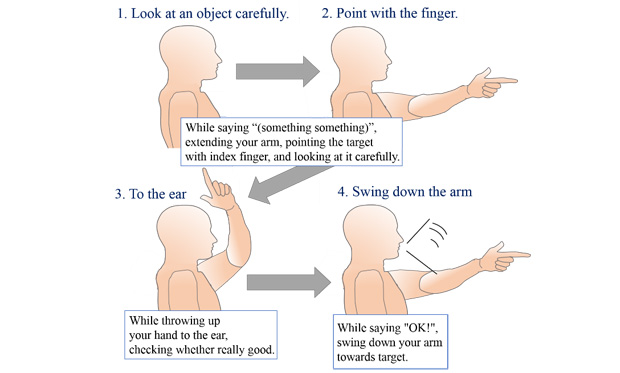Above: Figure 1: The way of “Finger Pointing and Calling”
Those who have been on a Japanese train might have observed a neatly uniformed employee, standing on the platform, making hand gestures whenever a train approaches or leaves the platform. Hand gestures are also performed by the driver or conductor inside the train as it approaches or leaves. These gestures are intended to keep us safe by heightening workers’ mental focus at key points on the job where accidents are likely to occur. This technique for error-prevention is called yubisashi kosho which, in English, roughly translates to “pointing and calling.” Japanese railway employees have been using this technique for many decades.
Japan Railway Technical Research Institute conducted research in 1994 in which workers who were asked to complete a simple task made 2.38 errors per 100 actions when no special steps were taken to prevent errors. When told to add just calling or just pointing as error prevention steps, their error rate dropped significantly. But the greatest reduction in error—to just 0.38 mistakes per 100 actions—was achieved when workers used both steps together. The combination of pointing and calling reduced mistakes by almost 85 percent. Some companies use only pointing, or only calling, but the technique is most effective when combined. Besides, pointing and calling allows for easy process confirmation. A supervisor observing the employee can easily verify that the signal has been seen and that the timetable has been checked. Hence, it is much easier to train operators and correct mistakes.
Pointing and calling combines looking at something, pointing at it, calling out the observation, and listening to your own voice. For example, when a speed limit starts in 500 meters, the train driver points at the sign and says, “Limit 65 Distance 500.” When leaving the station, the driver points at the timetable and says, “Five o’ clock 18 minutes 15 seconds depart Nagoya station.”
Pointing and calling has now been adopted by a wide range of Japanese industries and businesses. Three illustrations on how to do pointing and calling are available from the website of the Japan International Center for Occupational Safety and Health along with an English explanation on this concept. Searching the internet using keywords like ‘pointing and calling’ even yields videos where one can see this error prevention technique in action. In summary, finger pointing and calling (FPC) is performed compositely as shown in Figure 1 at the top of this article.
How FPC Works
In performing FPC, the brain is said to be activated by moving the arm and mouth while working the motor cortex, Broca’s area, and visual area simultaneously. When human error happens, the activation level of the brain is lower. Therefore, our idea is to observe brain activities by measuring blood flow to the brain when the human test subjects perform FPC while they are driving so that we might discern whether this method might be one way of reducing human error behind the wheel of a car, perhaps thereby lowering the probability of accidents.
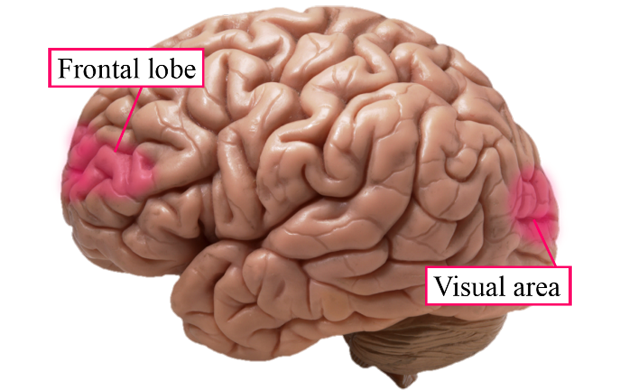
The measurement of brain activity occurring in association with the neural activity in the brain is captured by changes in cerebral blood flow dynamics using near-infrared spectroscopy (NIRS), a noninvasive technique that uses near-infrared light to evaluate an increase or decrease in oxygenated hemoglobin or deoxygenated hemoglobin in the tissue from the body surface. NIRS can detect the hemodynamic of the brain in real time while the subject is moving. Therefore, brain activity can be measured in various environments. It can measure oxygenated hemoglobin (oxy-Hb) and deoxygenated hemoglobin (deoxy-Hb) in cerebral blood flow. The change of oxy-Hb has a high association with the change of regional cerebral blood flow (rCBF) and increase in rCBF reflects an increase in neural activity. Therefore our study uses only oxy-Hb data to evaluate brain activity. The measured value shows relative variation of concentration from the beginning of the measurement. Previous studies by Shinohara, et al, [1] [2] and Kawada et al [3] suggested increased brain activation when using FPC, but the former studied the effect of FPC on cognitive control processes while the latter evaluated biological signals. Kishi et al [4] also reported on the effectiveness of FPC and introduced the concept of ‘imagined’ pointing and calling. We report on an extension of work done by Kishi et al [4] suggesting that the imagined pointing and calling has a similar effect as actual finger pointing and calling and therefore, can possibly be a safer alternative to reduce human error while driving.
As the frontal lobe is considered to be a part associated with attention, we measured blood flow in the frontal lobe in one experiment and since the primary visual area is associated with the visual attention, we also measured blood flow in the occipital visual area in our second experiment. Figure 2 shows the position of the brain’s frontal lobe and occipital lobe that deals with the visual perception area.
Studying FPC Using a Driving Simulator
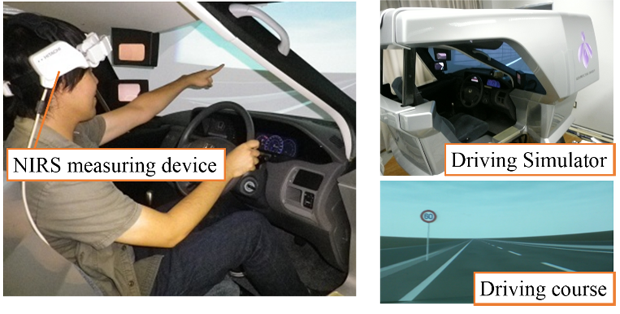
Our group conducted an experiment using a driving simulator to evaluate driving while using FPC. Our test subjects were four males and a female. They drove normally, and performed an indicated confirmation action three times when a traffic signal became visible in the front screen of the driving simulator as shown in Figure 3. There are four types of confirmation actions to compare their effects; reading silently, calling only, pointing only, and finger pointing and calling. These confirmation timings are shown in Figure 4. The frontal lobe activity was measured by wearing a 22 channel optical topography produced by HITACHI on the forehead as shown in Figure 5.


NIRS signals consist of the superimposition of various frequency bands, including content unrelated to brain activity such as noise or very slow upward-sloping fluctuations. Measured signals were therefore preprocessed with the multi-resolution analysis based on the discrete wavelet transform [5] to decompose them into multiple components, then noise and trends were removed by reconstituting the signal from selected components.
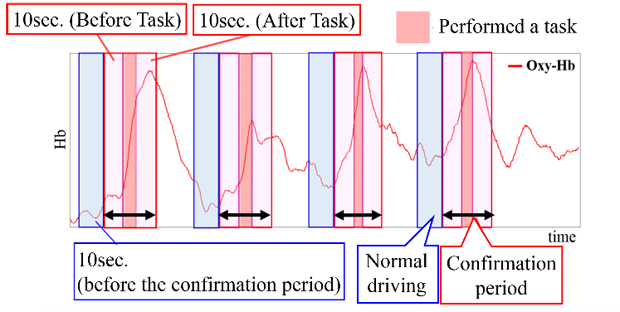
It took about 10 seconds to perform a task. Because blood flow does not change rapidly, we evaluate taking into account the time taken to perform this task before and after. Then, a period, which includes respectively 10 seconds before and after each task performance time, is defined as a “confirmation period” as shown in Figure 6. Ten seconds before the confirmation period is defined as “normal driving.” Data in a normal driving period are used to standardize data in the confirmation period. We derived averages of all subjects or all traffic signs in confirmation periods with respect to each confirmation action.
Oxy-Hb concentration (channel number 14) in a test subject’s driving with FPC is shown in Figure 7. Gray areas in Figure 7 show periods of performing FPC. The concentration of oxy-Hb has increased with performing of FPC. A similar trend was also observed in other subjects. The concentration of oxy-Hb had increased, and the brain activity had been invigorated by performing FPC.

The average of all subjects at each channel is shown in Figure 8, which means the state of brain activity for each confirmation action. When compared with confirmation actions, we can see that brain activity increased the most while performing FPC, Finger Pointing and Calling.
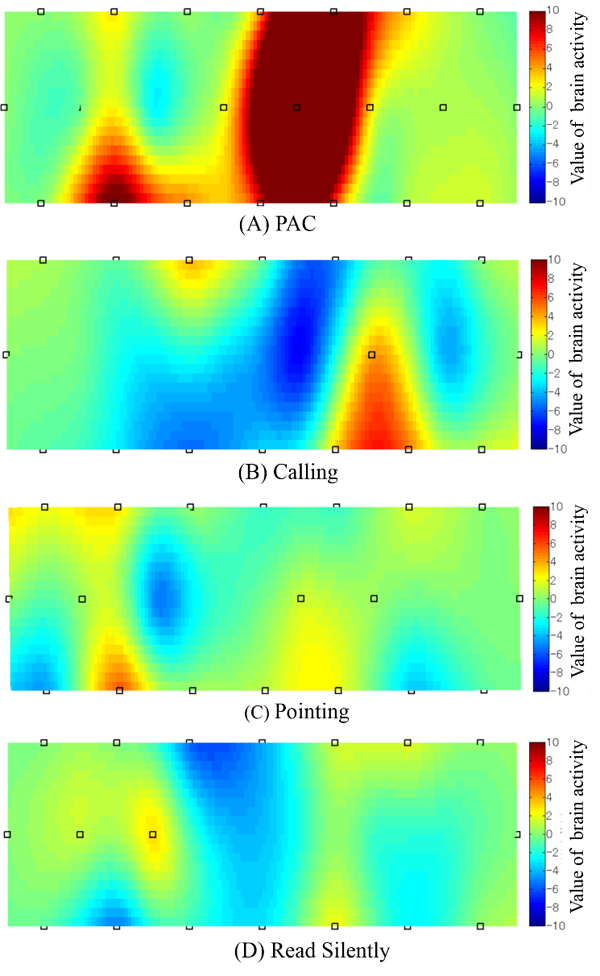
Verifying the Effectiveness of Imagined Pointing and Calling
We conducted a second experiment using a personal computer (PC) to verify the effect of IPC in comparison to FPC. The subjects performed experiments while they were watching a picture on a PC monitor. The experimental protocol consists of rest time (30 sec.) and task time (10 sec.) as shown in Figure 9. According to this protocol, the experiment is performed twice, once each for every FPC task and IPC task. By making the pre-rest period (60sec.) before measurement, we maintained a state of calm among the subjects. The presented picture is shown in Figure 10. In rest time, test subjects gazed at a “+” sign on a PC monitor, and were told to be in a state where they do not think of anything. In task time, the subjects performed FPC and IPC for traffic signs displayed one by one on a PC monitor.
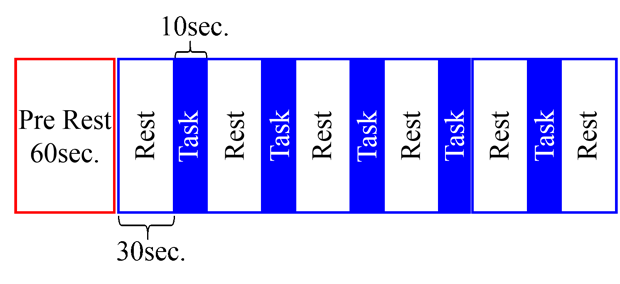
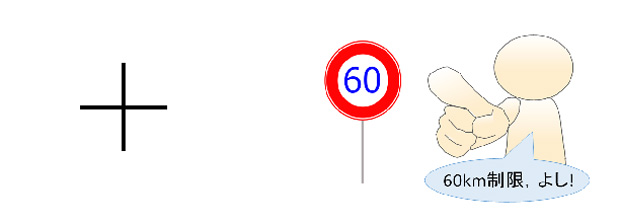
The human test subjects were again four males and one female. The frontal lobe activity on 22 channels and the visual area activity on 12 channels which are shown in Figure 11 were measured using FOIRE-3000 produced by Shimadzu Corporation.
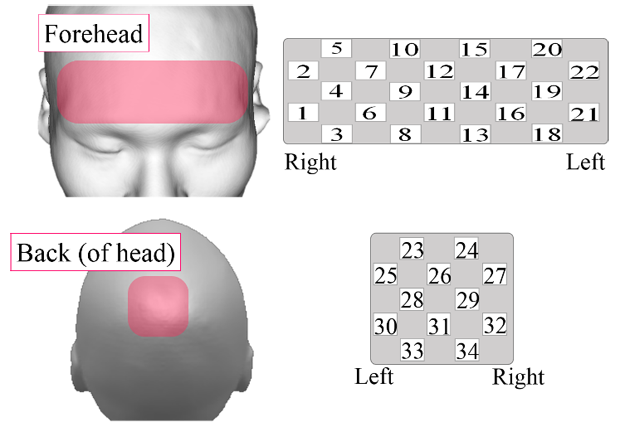
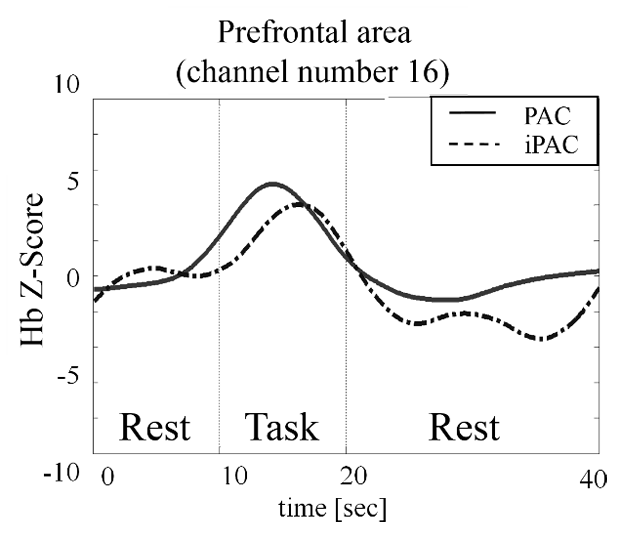
To make a comparison between FPC and IPC, waveforms of variability are shown in Figures 12 and 13, which have results of the prefrontal area (channel 16) and the visual area (channel 28). These two channels, 16 and 28, were chosen as they had clearer signals. The oxy-Hb concentration increased during the period of the task time at these two channels. Although the results were individual for each subject, all human test subjects showed the same tendency.
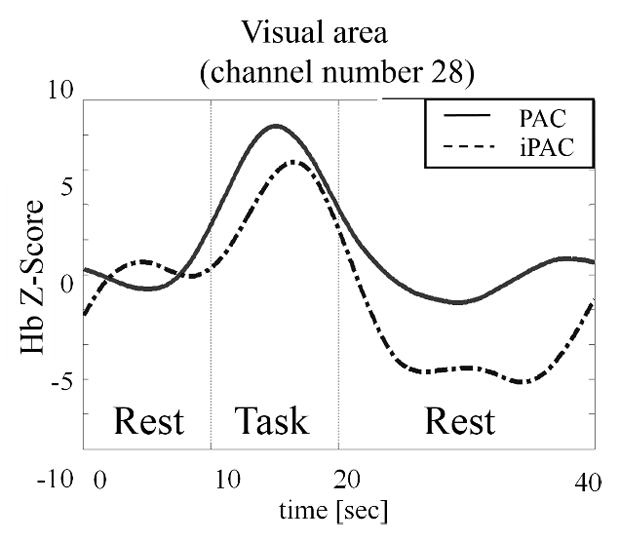
Figures 14 and 15 compare the brain activities for FPC and IPC. The value of brain activities shows how much brain activity increased while performing a task compared to the rest time (pre-rest).In the prefrontal area, the brain activity increased almost at the same level in both tasks. While, in the visual area, the brain activity increased conspicuously while doing the Finger Pointing and Calling (FPC). It could be confirmed that the results varied regionally.
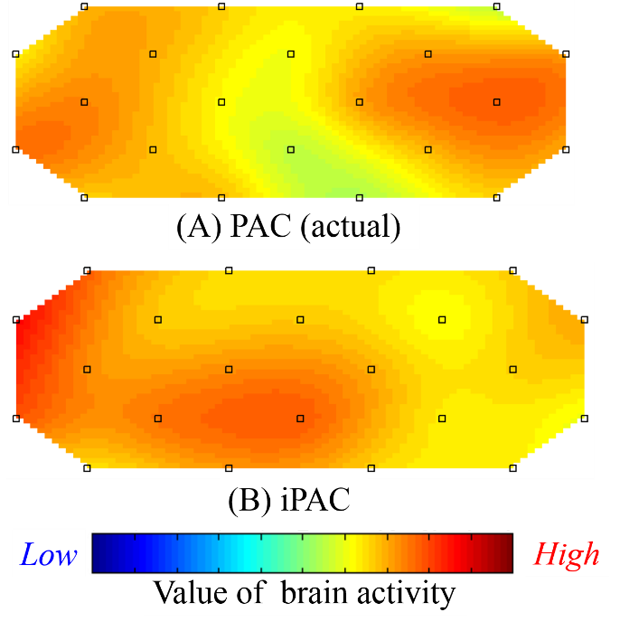
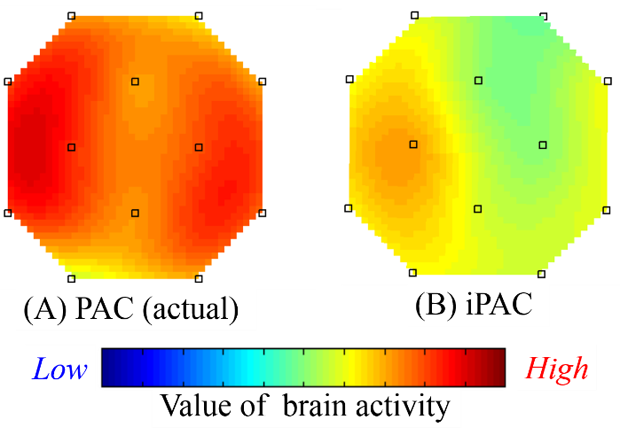
Clearly IPC shows promise as a way to ensure safety during driving, although future work is needed to verify whether or not these methods, FPC and IPC, are as effective in reducing human errors during actual driving as was found in the laboratory.
References
- Kazumitsu Shinohara, Katsuhiko Morimoto, Toshihiro Kubota, “Finger-pointing and call method contributing to sure orientation of visual attention”, SARMAC8, 2009.
- Kazumitsu Shinohara, Hiroshi Naito, Yuko Matsui, Masaru Hikono, “The effects of “finger pointing and calling” on cognitive control processes in the task-switching paradigm”, International Journal of Industrial Ergonomics 43, pp.129-136, 2013.
- Ayako Kawada, Yukiko Miyakoshi, Tomie Fujii, Toshio Kobayashi, Shino Tamura and Sachiko Teraoka,” Comparison of Variation in Regional Blood Flow in the Frontal Lobe during Confirmation Tasks Using the “Pointing and Calling” Method,” Japanese Society of Occupational Medicine and Traumatology, JJOMT Vol. 59, No. 1, 2011 (in Japanese with English abstract).
- C. Kishi, Y. Nakano, M. Shoaib Bhuiyan, H. Kawanaka, and K. Oguri. “Verification of the Effect on “Finger Pointing and Calling” Method from Observation of Brain Activity Related Driver’s Attention”,” Proceedings of the 17th Int’l IEEE Conference on Intelligent Transportation Systems, Oct 2014, FrB8.8, pp.1896-1897.
- Hitoshi Tsunashima and Kazuki Yanagisawa, “Measurement of Brain Function of Car Driver Using Functional Near-Infrared Spectroscopy (fNIRS)”, Computational intelligence and neuroscience, 2009.



